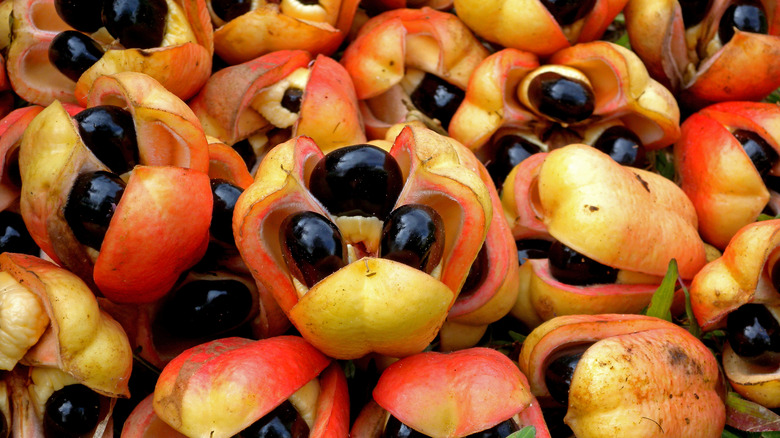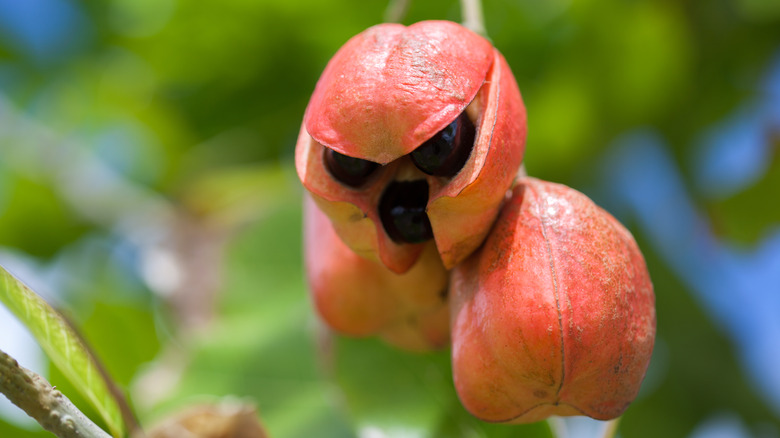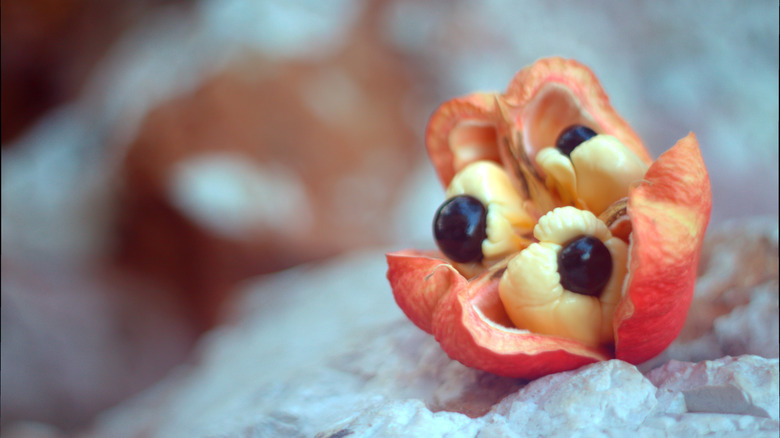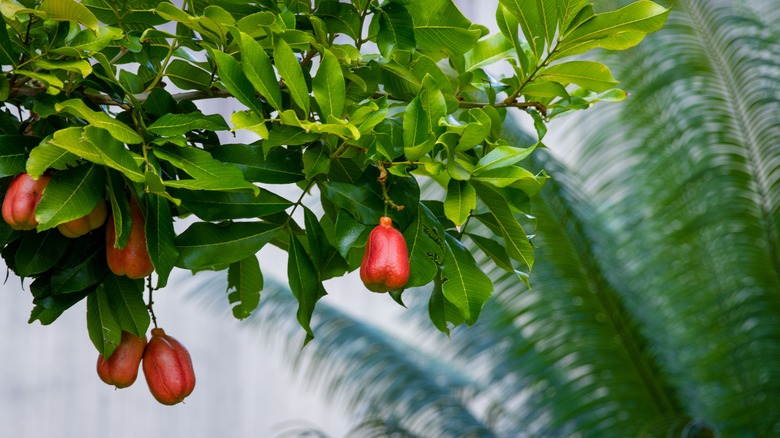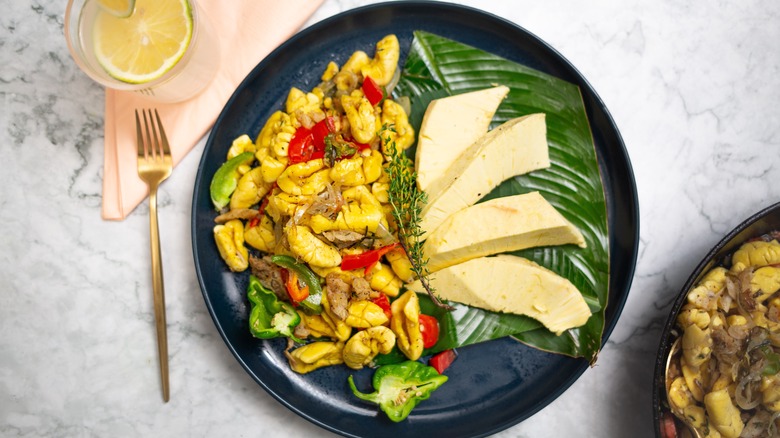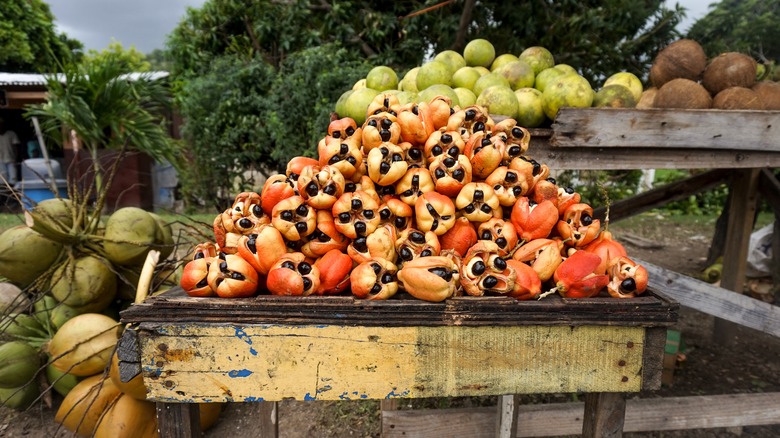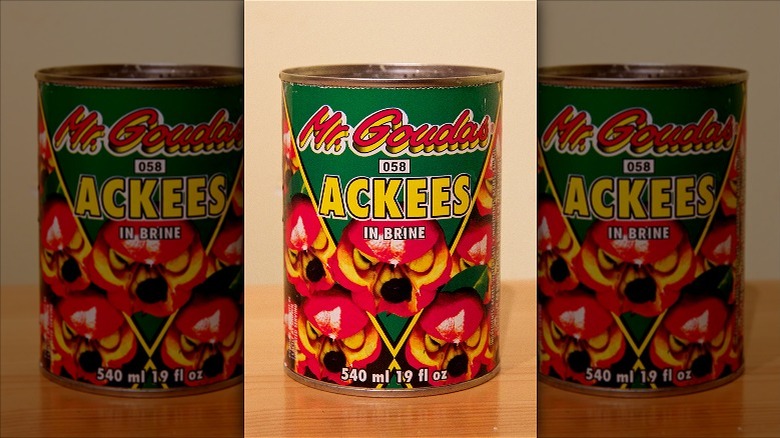What Is Ackee?
Ackee is a fruit that can be found in Africa, Latin America, and the West Indies but is originally native to West Africa. As the national fruit of Jamaica, it's a delicacy that has become pervasive across the island since its arrival in 1778. It requires finesse to prepare properly and safely, begging the question: Who was the first human to determine this fruit was edible, and how did they figure out when and how to eat it?
Unless you are visiting Jamaica or live there, the likelihood of consuming this fruit is slim because of strict regulations regarding its importation. That said, you can obtain it, but if you do, there are some things you should know about how to prepare, cook, and eat it. Let's take a closer look at this splendid specimen from the soapberry family of plants.
What is ackee?
Ackee, or Blighia sapida, is a tropical fruit that grows on an evergreen tree from the group of plants known as the soapberry family, which includes lychee and rambutan. Though this species originated in the Ivory Coast and Gold Coast of West Africa, it is now found throughout the Caribbean, Central America, South America, and even in Florida.
The name of the fruit evolved from the word Ankye in the Ghanaian Twi language. Its botanical name is attributable to Captain William Bligh, who brought the fruit from Jamaica to Britain in 1793. Other monikers include Akye fufo, Ankye, or Guinep.
There are 48 types, which fit into two subcategories: Butter and cheese. The arils of butter ackee are yellowish, tender, and luscious. They tend to fall apart easily when cooked. Cheese ackee, as its name indicates, looks like cheese, having a lighter off-white hue and more resilient texture capable of standing up to more aggressive culinary preparations.
What does ackee look like?
At first glance, images of ackee at various stages of development share a striking resemblance to the flesh-eating plant Audrey II from the musical "Little Shop of Horrors." The tree upon which ackee grows can reach up to 75 feet tall. This evergreen tree has a pronounced canopy of feather-like leaves. White five-petaled flowers form along shoots, which eventually develop to reveal the fruit.
Ackee fruit tends to be about 2 to 4 inches long and pear-shaped. Each fruit has two to four lobes that remain closed, giving it a similar ridged form to a bell pepper. The coarse skin begins green and slowly matures to a vermillion red as it ripens.
Once it is ripe, the lobes separate, allowing salmon-hued membranes with enormous black seeds adhered to fleshy arils to appear. The arils almost have a walnut-like shape as they blanket the seed pods with the pink membranes woven throughout the arils.
How did ackee get to Jamaica?
It would be impossible to disentangle Jamaican identity from the ackee fruit. As the national fruit and a key component to its most beloved dish, ackee and saltfish, Jamaicans have turned this unique plant into a culinary legacy. Its arrival to the West Indies from West Africa is a stark reminder of the British slave trade, which didn't conclude until 1807. During the latter part of the 18th century, over one million African slaves were transported to Jamaica to work the sugar plantations.
The enslaved Africans would often adorn themselves with necklaces fashioned from seeds, a symbol of good luck that would accompany them along their arduous journey across the Atlantic Ocean. One such seedpod was that of the ackee fruit. The fruit found its way onto Jamaican soil, where they found a climate ideally suited to their proliferation.
African women simultaneously became workers on the sugar plantations. There they were charged with providing nourishing food to themselves and their families to help them endure the long work days. Their knowledge of how to utilize ackee enabled them to reap the nutritional benefits of this fruit, thereby solidifying its importance in the sustenance of a generation that has continued to this day.
What does ackee taste like?
The portion of the ackee fruit that gets consumed is its aril, the fleshy part that envelops the large black seeds in the pod. This seed-covering is often compared to scrambled eggs because it's similar in color and tends to dissolve once separated from the pit and membrane. However, it tastes nothing like them.
Though ackee tends to be served cooked, if consumed when raw, you'll notice a mellow sweetness with a hint of mineral earthiness redolent of avocado and almonds. The oily, fatty fruit yields when cooked, dissolving and absorbing the flavors of everything around it.
Ackee is occasionally compared with cheese fruit or noni. Some also find it similar to vegetable marrow – a very ripe squash, except it is not as acrid, doesn't smell foul, and is far more luscious in texture. When baked, its flavor develops a nuttiness comparable to peanut butter. And when used in custards, its more cloying sweetness comes forward, highlighting the complexity of the fruit.
How to cook with ackee
Though you can prepare ackee in myriad ways, none are more popular or as important to the culinary identity of Jamaica as ackee and saltfish. This dish is made with reconstituted salt cod with ackee, onions, tomatoes, scallions, Scotch bonnet chile peppers, thyme, and allspice. It's served for breakfast alongside roasted breadfruit, boiled green banana, johnnycake, and pan-fried plantain.
Ackee is also commonly boiled and fried before being added to various salads, soups, curries, and stews. And it is a primary ingredient in many dishes featured in Ital cooking, a vegetarian culinary tradition associated with Jamaican Rastafarians. This type of cuisine relies heavily on natural, whole foods that are fresh and prepared without sugar or animal products.
And finally, ackee is superb when used in sweeter applications like smoothies, cakes, custards, quickbreads, mousse, and ice cream. As long as ackee is ripe and sourced from a reputable retailer, the sky's the limit with what you can do with it.
Is ackee toxic?
Dubbed one of the "Top 10 Most Dangerous Foods" by Time. Ackee can sometimes be toxic and is known for causing what is known as "Jamaican Vomiting Sickness." This condition arises within 6 to 48 hours of consuming unripened ackee, causing severe nausea, vomiting, fatigue, hypoglycemia, coma, and death.
The culprit of this illness is a heat-stable amino acid known as hypoglycin A. This toxin is present in the seeds, rinds, and arils when unripe. As the fruit ripens, the aril loses its toxicity, rendering it safe to eat.
The key is allowing the fruit to fully ripen on its own. Once it does, the pod will split and open up, revealing the seeds and arils within. Jamaicans have given this process within the life-cycle of the fruit the moniker "smiling" or "yawning." Once fully exposed, the arils of the ackee are harvested, and the seeds are discarded. The arils should be boiled in water to further eliminate any remaining hypoglycin A, which is water soluble.
Ackee should never be forced open or prematurely harvested as there is no way to neutralize the hypoglycin, which in unripe green ackee can reach 1,000 parts per million (ppm). The recognized safe level designated by the FDA is 100 parts per million (ppm). For this reason, it is always recommended that you only consume ackee prepared by someone properly trained to work with it or from canned products that have been inspected and are on the "Green List ” of the FDAs Import Alert.
Nutritional information about ackee
Despite the potential toxicity of consuming unripened ackee, this fruit is a nutritional powerhouse. As a plant source, ackee is rich in fiber and protein. According to Health Benefits Times, this fruit is loaded with vitamin B3, vitamin C, folic acid, potassium, iron, calcium, zinc, and sodium. These nutrients may lead to benefits such as healthier bones, improved digestion, a boost in immunity, regulation of blood sugar levels, and minimizing muscle cramping that is common with dehydration and muscle exertion.
Where ackee really shines, however, is in its preponderance of fatty acids. That includes stearic, linoleic, and palmitic acids. These unsaturated fats may help reduce overall cholesterol levels, benefiting heart health by reducing the risk of developing atherosclerosis, strokes, heart attacks, and coronary heart disease.
And finally, ackee is commonly used in several folk medicine traditions. Many use it to create various salves that help treat skin conditions ranging from ulcers to infections. Beverages are also brewed from it that soothe digestive discomfort. And other pastes or porridges are concocted to reduce symptoms of pain, eye infections, and tooth decay and to reduce fever.
Where to buy ackee
Because of the dangers associated with consuming unripened ackee, its importation is strictly regulated by the FDA. Though fresh ackee is unavailable in the U.S., you can purchase ackee that is canned, frozen, dried, in preserves, in pulp form, as a beverage, as toppings, and a few prepared ackee products that have met strict regulatory standards established by the FDA.
The FDA evaluates products on a processor-to-processor basis, ranking each for safety. Those landing on the Yellow List can have their products detained at the border without physical inspection. Those on the Green List have been fully cleared as safe and can be obtained from numerous sources.
A simple Google search will instantly reveal an extensive list of products you can obtain online. Before placing an order, we recommend referring to the FDAs Import Alert on Ackee to ensure the product you buy comes from a company that has met the criteria for exclusion from Detention without Physical Examination (DWPE).
We also recommend checking reviews to obtain quality products before investing in them. And finally, you should consider following any instructions on a product obtained to guarantee proper preparation for both the safety and quality of a recipe — including draining the ackee of any canning liquid before using it.
How to store ackee
As a general rule of thumb, if you can obtain fresh ackee, you should use it immediately. If you cannot consume it promptly, it is recommended that you blanch the arils and freeze them for future use. Cooked ackee can be stored in the refrigerator for three to four days. If you are adept at canning, you may preserve ackee arils in brine for long-term storage.
For canned ackee, follow the expiration dates on the can to ensure you are consuming it in a timely fashion. And always pay attention to any damage to the can, such as dents or swelling, which may indicate it has been contaminated and is unsafe to consume. We recommend repackaging unused portions of canned ackee into a glass, plastic, or ceramic container with a tight sealing lid or a ziplock baggie for storage in the refrigerator. Repackaged ackee can last up to seven days.
Alternately you can drain the ackee from its brine, repackage it, and freeze it for two to three days after opening the can for up to three months for best quality. It may last longer unless it begins to develop freezer burn.
Be sure to label your containers clearly with the date when it was frozen. When defrosting the frozen fruit, always do so overnight in the refrigerator to prevent bacterial contamination. And finally, do note that canned fruit tends to get much softer after freezing, so it may not be suitable for some recipes, like the popular saltfish with ackee dish.
